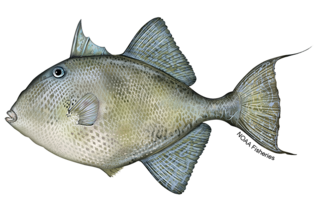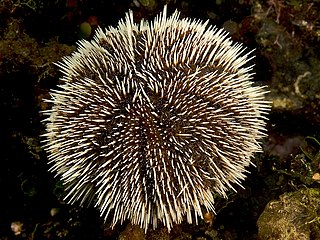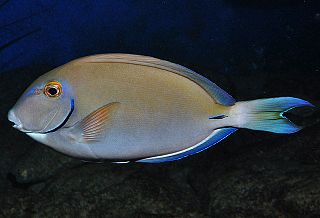
The filefish (Monacanthidae) are a diverse family of tropical to subtropical tetraodontiform marine fish, which are also known as foolfish, leatherjackets or shingles. They live in the Atlantic, Pacific and Indian Oceans. Filefish are closely related to triggerfish, pufferfish and trunkfish.

The lane snapper, the Mexican snapper, redtail snapper or spot snapper, is a species of marine ray-finned fish, a snapper belonging to the family Lutjanidae. It is native to the western Atlantic Ocean.

The grey triggerfish, or gray triggerfish, is a species of ray-finned fish in the triggerfish family. The species is native to shallow parts of the western Atlantic from Nova Scotia to Argentina and also the eastern Atlantic, the Mediterranean Sea and off Angola on the west coast of Africa.

The black goby is a species of ray-finned fish found in the Eastern Atlantic and Mediterranean Sea and Black Sea. It inhabits estuaries, lagoons, and inshore water over seagrass and algae. It feeds on a variety of invertebrates and sometimes small fish. This species can also be found in the aquarium trade.

The bar jack, also known as the carbonero, red jack, blue-striped cavalla or passing jack, is a common species of inshore marine fish classified in the jack family, Carangidae. The bar jack is distributed through the western Atlantic Ocean from New Jersey and Bermuda in the north to Venezuela and possibly Brazil in the south, with the largest population in the Gulf of Mexico and West Indies. The bar jack is most simply distinguished from similar jacks by its dark horizontal bar which runs along the back and down the caudal fin, often accompanied by an electric blue stripe immediately below it. Other more detailed differences include dentition and soft ray counts. The bar jack is a moderately large species, growing to a recorded maximum of 65 cm and a weight of 6.8 kg. The species inhabits clear shallow waters, often over coral reefs where it lives either solitarily or in large schools, taking various fishes, crustaceans and cephalopods as prey. Studies in Cuba indicate spawning occurs between March and August, with sexual maturity reached at 26 cm. It is a relatively popular sport fish and can be caught on light tackle with a variety of lures and baits. It is considered to be a good food fish, however many recorded ciguatera cases are attributed to the species, with most cases reported on the island of St. Thomas traced to this single species.

Lytechinus variegatus, commonly called the green sea urchin or the variegated sea urchin, is a species of sea urchin that can be found in the warm waters of the western Atlantic Ocean and Caribbean Sea.

The yellowfin whiting, also known as the western sand whiting or fine-scaled whiting, is a species of inshore marine fish in the smelt-whiting family Sillaginidae. The species is endemic to the eastern Indian Ocean, ranging from Dampier, Western Australia to Gulf St Vincent in South Australia, with an apparent division in the populations of the two states. Yellowfin whiting inhabit relatively shallow waters for their entire life, often found on tidal flats and creeks, as well as large estuaries. It is one of the largest members of the smelt-whiting family, growing to 42 cm, and can be distinguished by a number of anatomical and colour related features. Yellowfin whiting are benthic carnivores, preying predominantly on polychaete worms, with minor amounts of copepods, amphipods and bivalves also commonly taken. The species shows a change in diet with age, and also dietary differences with other sillaginids presumably to minimize competition. Reproduction occurs at different times throughout its range, generally focused around summer, with up to 217,000 eggs produced per season. Yellowfin whiting reach sexual maturity at around 20 cm, with each individual spawning more than once. The species forms the basis of major fisheries in both Shark Bay, Western Australia and the two Gulfs of South Australia, with around 260 tonnes of fish taken each year. They are also a popular target for shore based anglers, with a reputation as a very good table fish.

Coastal fish, also called inshore fish or neritic fish, inhabit the sea between the shoreline and the edge of the continental shelf. Since the continental shelf is usually less than 200 metres (660 ft) deep, it follows that pelagic coastal fish are generally epipelagic fish, inhabiting the sunlit epipelagic zone. Coastal fish can be contrasted with oceanic fish or offshore fish, which inhabit the deep seas beyond the continental shelves.

Tripneustes ventricosus, commonly called the West Indian sea egg or white sea urchin, is a species of sea urchin. It is common in the Caribbean Sea, the Bahamas and Florida and may be found at depths of less than 10 metres (33 ft).

The seaweed blenny is a species of combtooth blenny found in coral reefs in the western Atlantic Ocean along the coasts of New York, Bermuda, the Bahamas, also in the Gulf of Mexico, south to southern Brazil. This species reaches a length of 8.5 centimetres (3.3 in) TL.

Acanthurus tractus, the five-band surgeonfish, ocean surgeon, or ocean surgeonfish, is a species of ray-finned fish in the family Acanthuridae found in the western Atlantic Ocean, Florida, the Bahamas, the Caribbean Sea and the Gulf of Mexico. Until recently, it was considered a synonym of Acanthurus bahianus, but its status as a separate species was resurrected in 2011.

The Gulf pipefish is a species of pipefish in the member of the taxonomic family Sygnathidae. Syngnathus scovelli is native to the region of south Florida, United States, the Atlantic Ocean, etc. S. scovelli is similar to the species Opossum pipefish also known by its scientific name as Microphisbrachyurus.

Stegastes leucostictus is a species of damselfish found near the sea bed in shallow waters on the western fringes of the Atlantic Ocean. It is commonly known as the beau gregory or beaugregory.

Stephanolepis cirrhifer, commonly known as the thread-sail filefish, is a species of marine fish in the family Monacanthidae. It is found in the western Pacific, in an area that ranges from northern Japan to the East China Sea, to Korea. Other common names for the fish include kawahagi (カワハギ,皮剥) (Japanese) and “쥐치” "Jwi-chi" (Korean). The fish grows to a maximum length of about 12 inches, and consumes both plant material and small marine organisms like skeleton shrimp. S. cirrhifer is host of the parasite Peniculus minuticaudae. Some minor genetic differentiation between S. cirrhifer born in the wild and those bred in a hatchery for consumer use has been shown. The fish is edible and sold commercially for culinary purposes in many Asian countries.

Monacanthus chinensis, commonly known as the fan-bellied leatherjacket or fantail leatherjacket, is a species of filefish native to the western Pacific Ocean and the eastern Indian Ocean where it is found on reefs and soft sediments at shallow depths. This species grows to a total length of 40 centimetres (16 in).

Menticirrhus saxatilis, the northern kingfish or northern kingcroaker, is a species of marine fish in the family Sciaenidae. It lives in the shallow coastal waters of the western Atlantic Ocean and Gulf of Mexico.

Monacanthus is a genus of filefishes.

Ogcocephalus radiatus or the polka-dot batfish is an arrow-shaped fish in the family Ogcocephalidae with an elongated thin tail. It is dorso-ventrally flattened with round pectoral fins that sit flat on the bottom of the sea floor. It uses its pectoral fins and pelvic fins to "walk" along the bottom in a side-to-side shuffling motion.

The orangespotted filefish is a species of filefish described by Ranzani in 1842. and it is native to shallow waters in the tropical and subtropical Atlantic Ocean, the Caribbean Sea and the Gulf of Mexico.

Stephanolepis diaspros, commonly known as the reticulated filefish or the reticulated leatherjacket, is a species of bony fish, a ray-finned fish in the family Monacanthidae. Its natural range is the western Indian Ocean but it is also one of the species which has colonised the Mediterranean through the Suez Canal by Lessepsian migration from the Red Sea.




















